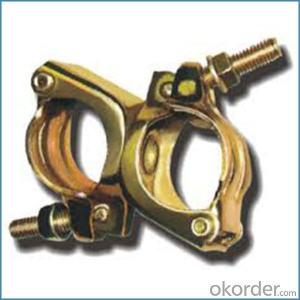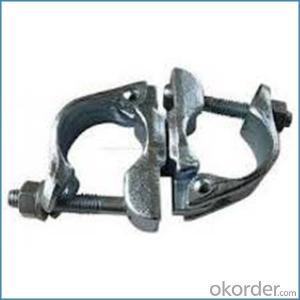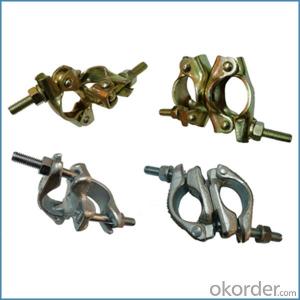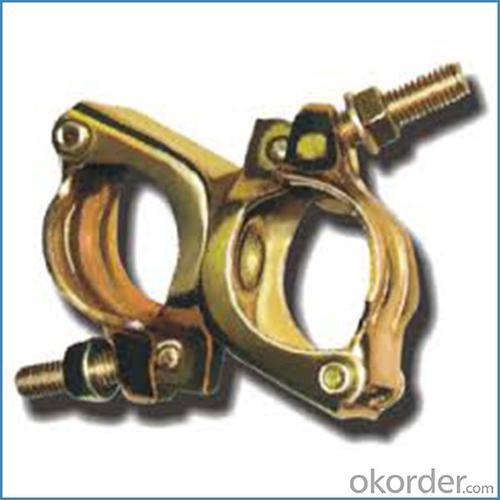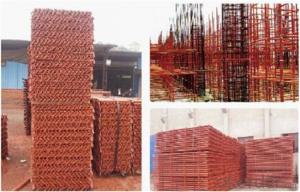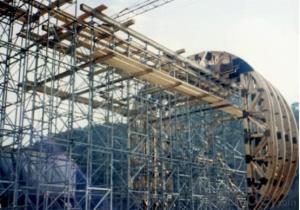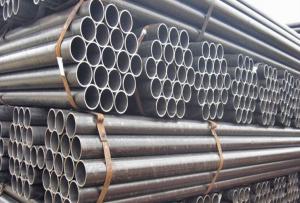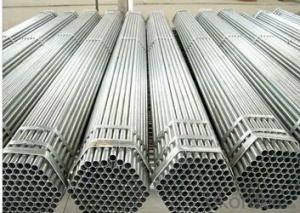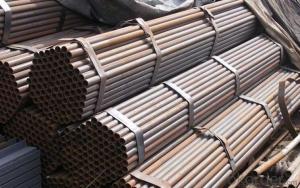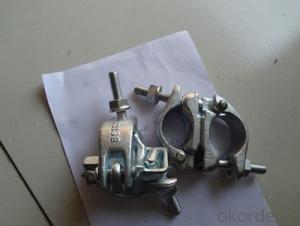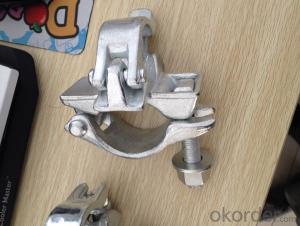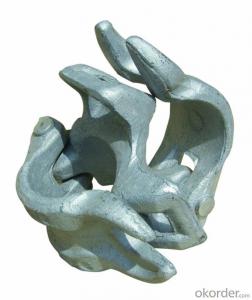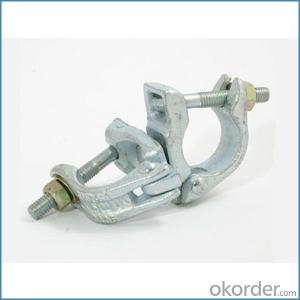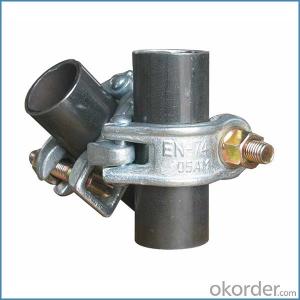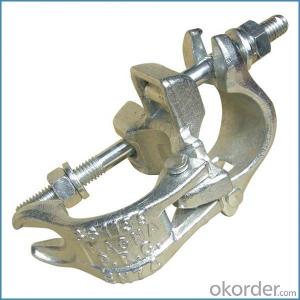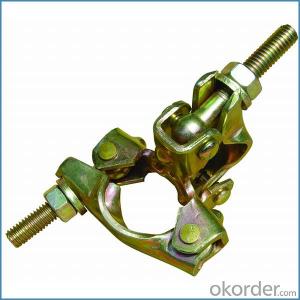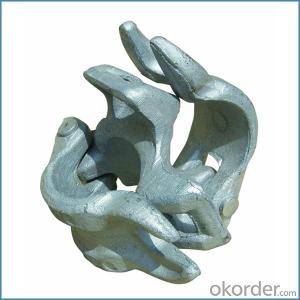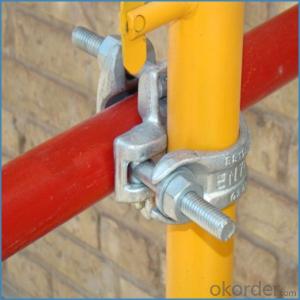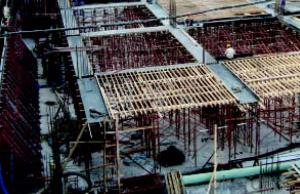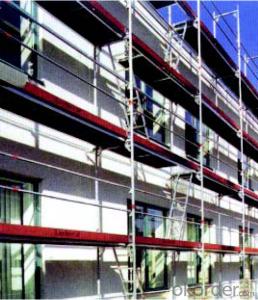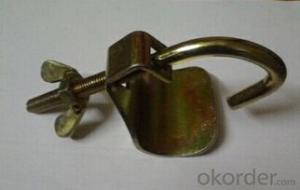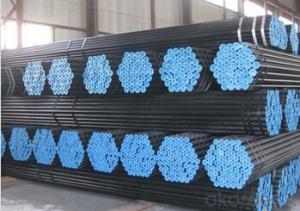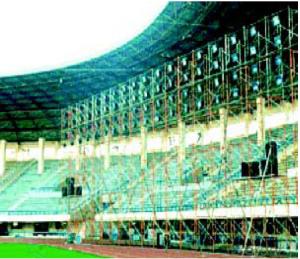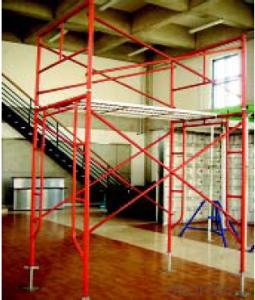Metal Scaffold Couplers British Type for Sale
- Loading Port:
- Tianjin
- Payment Terms:
- TT OR LC
- Min Order Qty:
- 1000 kg
- Supply Capability:
- 100000 kg/month
OKorder Service Pledge
OKorder Financial Service
You Might Also Like
Metal Scaffold Couplers British Type for Sale
Description
1.The scaffolding coupler is always used to connect the steel pipe as scaffolding system.
2.The often used coupler is swivel coupler and righ angle coupler .
3.We can provide types of scaffolding coupler according to your requirement.
4.Couoler can fix the 48.3mm scaffolding steel pipe tightly and make the whole scaffolding system more steadily.
5.Material:Q235 steel
6.Overall Size:48.3mm*48.3mm
7.Surface Finish: Galvanized/ Painted
8.Standard:BS1139,EN74
9.Package:25pcs/bag
10.Manufactuering as per customer requirements
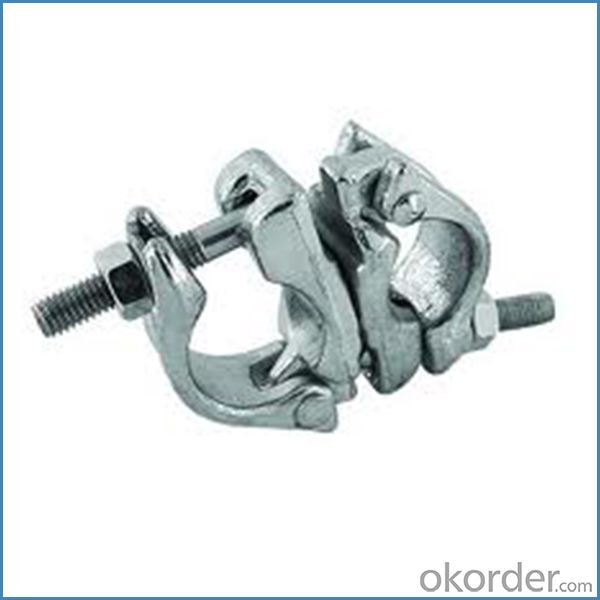
Feature
(1)Excellent Anti-Breaking—Cold Pressed Steel
(2)Outstanding Resistance Deformation
(3)Strong Anti-Dropping Ability
(4)Longtime USe
(5)Qualtity Guaranteed
(6)OEM Service
Photo
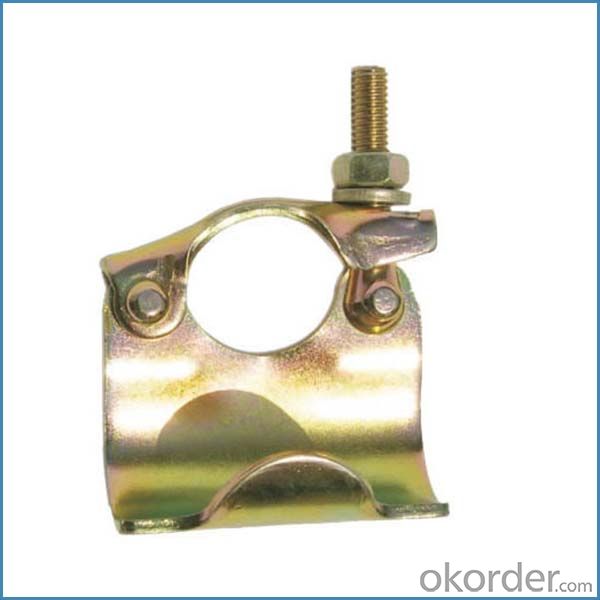
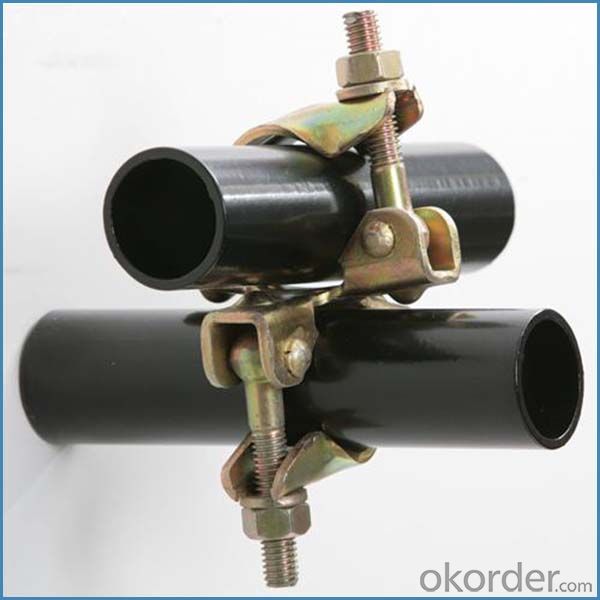
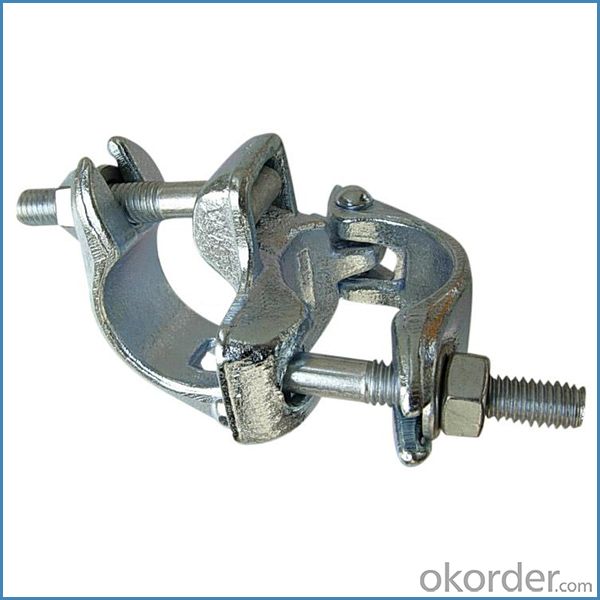
Parameter
| Material | Q235,345steel |
| Size | 48.3mm*48.3mm |
| Surface finish | Galvanized |
| Weight | 1.1kg around |
| Standard | BS1139,EN74 |
| Package | 25pcs/bag,steel pallet |
| Manufacture | As per customer requirement |
| Market | Africa, South America, the Middle East and Asia |
FAQ
Q: Are you a factory or trading company?
We are a state-owned corporation in China,dealing with various kinds of building materials.We have our holding subsidiaries.
Q: Where is your factory located? How can I visit there?
Our factory is located all around China.
Q: Can I get some samples?
Sample is free, customer only pay freight for the first time.
Q: Delivery?
10-30days. (5-15 containers)
Any question,feel free to contact us.
- Q: Are steel tube couplers adjustable to accommodate different tube diameters?
- No, steel tube couplers are not typically adjustable to accommodate different tube diameters. Steel tube couplers are designed to provide a secure and rigid connection between two tubes of the same diameter. They are manufactured to fit specific tube sizes and cannot be adjusted to accommodate different diameters. If you need to connect tubes of different diameters, you would typically need different couplers that are specifically designed for those particular sizes.
- Q: What safety precautions should be followed when using steel tube couplers in scaffolding?
- To ensure the well-being of workers and the stability of the structure, it is crucial to adhere to specific safety measures when utilizing steel tube couplers in scaffolding. Here are some essential precautions that should be observed: 1. Quality Assurance: Give priority to employing high-quality steel tube couplers that adhere to industry standards and have undergone strength and durability testing. This will help prevent any potential failures or accidents. 2. Inspection: Prior to usage, thoroughly examine the couplers for any damage such as cracks, deformities, or rust. Any damaged couplers should be promptly replaced to avoid compromising the integrity of the scaffolding. 3. Proper Installation: Ensure that the couplers are installed correctly by following the manufacturer's instructions. This includes securely fastening the coupler bolts using the appropriate tools. Loose or improperly installed couplers can lead to instability and potential accidents. 4. Load Capacity: Take into consideration the load capacity of both the couplers and the scaffolding system. Do not exceed the maximum load capacity specified by the manufacturer. Overloading can cause the couplers to fail and jeopardize the safety of workers. 5. Secure Connections: Verify that all connections between tubes and couplers are secure and tight. Loose connections can result in instability and create hazardous conditions for workers. 6. Regular Inspections: Conduct routine inspections of the scaffolding and couplers during usage. Look for any signs of wear, damage, or loose connections. If any issues are identified, take immediate action to repair or replace the affected components. 7. Fall Protection: Always provide appropriate fall protection equipment, such as harnesses and guardrails, in addition to utilizing steel tube couplers. The safety of workers operating at heights should never be compromised. 8. Training and Competence: Ensure that workers utilizing steel tube couplers in scaffolding are adequately trained and competent to do so. They should understand the proper installation procedures, load capacities, and safety precautions. 9. Weather Conditions: Take into account weather conditions when employing steel tube couplers in scaffolding. Wind, rain, or other adverse weather factors can impact the stability of the structure. Additional precautions or temporary measures may be necessary to ensure safety. 10. Documentation: Maintain proper documentation of inspections, repairs, and any modifications made to the scaffolding system. This documentation can be valuable in monitoring the safety of the system and identifying any potential issues. By adhering to these safety precautions, the risks associated with utilizing steel tube couplers in scaffolding can be significantly reduced, ultimately promoting a safe working environment for all workers involved.
- Q: What are the maximum heights that can be achieved using steel tube couplers?
- The height that can be reached using steel tube couplers relies on several factors, including the size and strength of the steel tubes, the structure's design and stability, and the load requirements for a particular application. In construction and scaffolding projects, steel tube couplers are commonly employed to connect steel tubes and create a secure framework. The height achieved with steel tube couplers is determined by the load-bearing capacity of the couplers, the strength of the steel tubes, and the overall stability of the structure. Generally, steel tube couplers are designed to support a specific amount of weight and ensure stability in the structure. The maximum height attainable with steel tube couplers relies on the load capacity of the couplers and the strength of the steel tubes. To ensure the height remains within safe limits set by industry standards and regulations, it is essential to consult engineering guidelines and specifications. Moreover, other factors like wind loads, seismic conditions, and safety considerations can influence the maximum height achievable with steel tube couplers. Conducting engineering calculations and structural analysis is necessary to assess the stability and integrity of the structure at greater heights. Ultimately, the maximum height achievable with steel tube couplers varies according to the specific application, design, and engineering considerations. It is crucial to collaborate with experienced professionals and adhere to industry guidelines to guarantee the safety and stability of the structure.
- Q: A 67.0kg- painter is on a uniform 23kg- scaffold supported from above by ropes. There is a 3.6kg- pail of paint to one side, as shown .
- Painter Scaffold
- Q: Can steel tube couplers be used for scaffolding projects with complex load transfer mechanisms?
- Scaffolding projects with complex load transfer mechanisms can utilize steel tube couplers. These couplers are extensively used in the construction industry to connect and join scaffolding tubes, ensuring a secure and dependable connection that maintains the stability and strength of the scaffolding structure. Steel tube couplers offer numerous advantages when dealing with complex load transfer mechanisms. Firstly, they have the capability to handle heavy loads and are designed to evenly distribute weight, minimizing the risk of structural failure. Additionally, these couplers provide flexibility in terms of adjusting the angles and positioning of scaffolding tubes, allowing for customization and adaptation to various load requirements. Furthermore, steel tube couplers are highly durable and resistant to wear and tear, making them suitable for long-term and demanding projects. They are also easy to install and dismantle, simplifying the modification or reconfiguration of the scaffolding structure as needed. However, it is crucial to select the appropriate type and size of steel tube couplers based on the specific project requirements. Complex load transfer mechanisms may necessitate specialized couplers that are specifically designed to handle the unique load distribution and transfer characteristics. Seeking guidance from a structural engineer or a scaffolding expert can aid in determining the most suitable couplers for the project. In summary, steel tube couplers serve as a reliable and efficient solution for scaffolding projects with complex load transfer mechanisms. They provide strength, stability, and versatility, making them an ideal choice for a wide range of construction applications.
- Q: Exterior scaffolding step, pitch, span, respectively, what is the meaning
- High fall, object blow, electric shock, collapse, mechanical damage (lifting damage).
- Q: Are steel tube couplers compatible with scaffolding systems using different tube lengths?
- Steel tube couplers are generally compatible with scaffolding systems that use different tube lengths. The purpose of steel tube couplers is to connect and secure the tubes used in scaffolding systems. These couplers are designed to accommodate various tube sizes and lengths, allowing for versatility and adaptability in scaffolding construction. The key factor to consider when using steel tube couplers with scaffolding systems of different tube lengths is ensuring that the couplers have the appropriate size and strength to handle the load and maintain the stability of the structure. It is crucial to select couplers that are compatible with the specific tube sizes and lengths being used in the scaffolding system. In some cases, additional measures may be required, such as using adjustable couplers or providing additional support to account for the varying tube lengths. It is also essential to follow the manufacturer's guidelines and specifications for the couplers to ensure safe and reliable scaffolding construction. Overall, with the right selection and proper installation, steel tube couplers can be compatible with scaffolding systems using different tube lengths, providing the necessary structural integrity and stability required for safe and efficient construction projects.
- Q: Are steel tube couplers compatible with other scaffolding components?
- Yes, steel tube couplers are compatible with other scaffolding components. Steel tube couplers are commonly used in construction and scaffolding industries to connect steel tubes or pipes together to form a stable and secure structure. These couplers are designed to fit standard size steel tubes and are compatible with various scaffolding components such as scaffold boards, base plates, diagonal braces, and horizontal ledgers. Steel tube couplers are available in different types, including single couplers, double couplers, swivel couplers, and sleeve couplers, each designed for specific connections and applications. These couplers are manufactured to industry standards, ensuring their compatibility with other scaffolding components manufactured to the same specifications. When using steel tube couplers, it is important to ensure that they are correctly installed and tightened to provide a safe and stable connection. Regular inspections and maintenance of scaffolding components, including couplers, are crucial to ensure their continued compatibility and safe usage. In summary, steel tube couplers are compatible with other scaffolding components and are widely used in the construction industry to create robust and secure scaffolding structures.
- Q: Can steel tube couplers be used for scaffolding projects with complex load transfer mechanisms?
- Yes, steel tube couplers can be used for scaffolding projects with complex load transfer mechanisms. Steel tube couplers are designed to securely connect scaffold tubes, providing a reliable and strong connection. Their versatility allows for the construction of complex scaffolding structures that can handle various load transfer mechanisms, ensuring safety and stability in the project.
- Q: How do steel tube couplers ensure the stability and rigidity of scaffolding structures during use?
- Steel tube couplers ensure the stability and rigidity of scaffolding structures during use by providing a secure connection between the steel tubes. These couplers are designed to grip the tubes tightly, preventing any movement or slippage. This ensures that the scaffolding remains stable and rigid, even when subjected to various loads and forces. The strong and reliable connection created by the couplers enhances the overall structural integrity of the scaffolding, ensuring the safety of workers and the stability of the platform.
Send your message to us
Metal Scaffold Couplers British Type for Sale
- Loading Port:
- Tianjin
- Payment Terms:
- TT OR LC
- Min Order Qty:
- 1000 kg
- Supply Capability:
- 100000 kg/month
OKorder Service Pledge
OKorder Financial Service
Similar products
Hot products
Hot Searches
Related keywords
